Looking to bring some greenery and life into your indoor space? Indoor vining and climbing plants are an excellent choice! Not only do they add a touch of natural beauty, but they also provide a dynamic element as they gracefully trail and climb their way through your home.
Whether you prefer cascading vines or vertical climbers, these plants will bring a sense of vibrancy and vitality to every corner. So, get ready to let your indoor space climb to new heights of beauty with the following best and most dynamic indoor vining and climbing plants!
1. Porcelain Flower (Hoya carnosa)
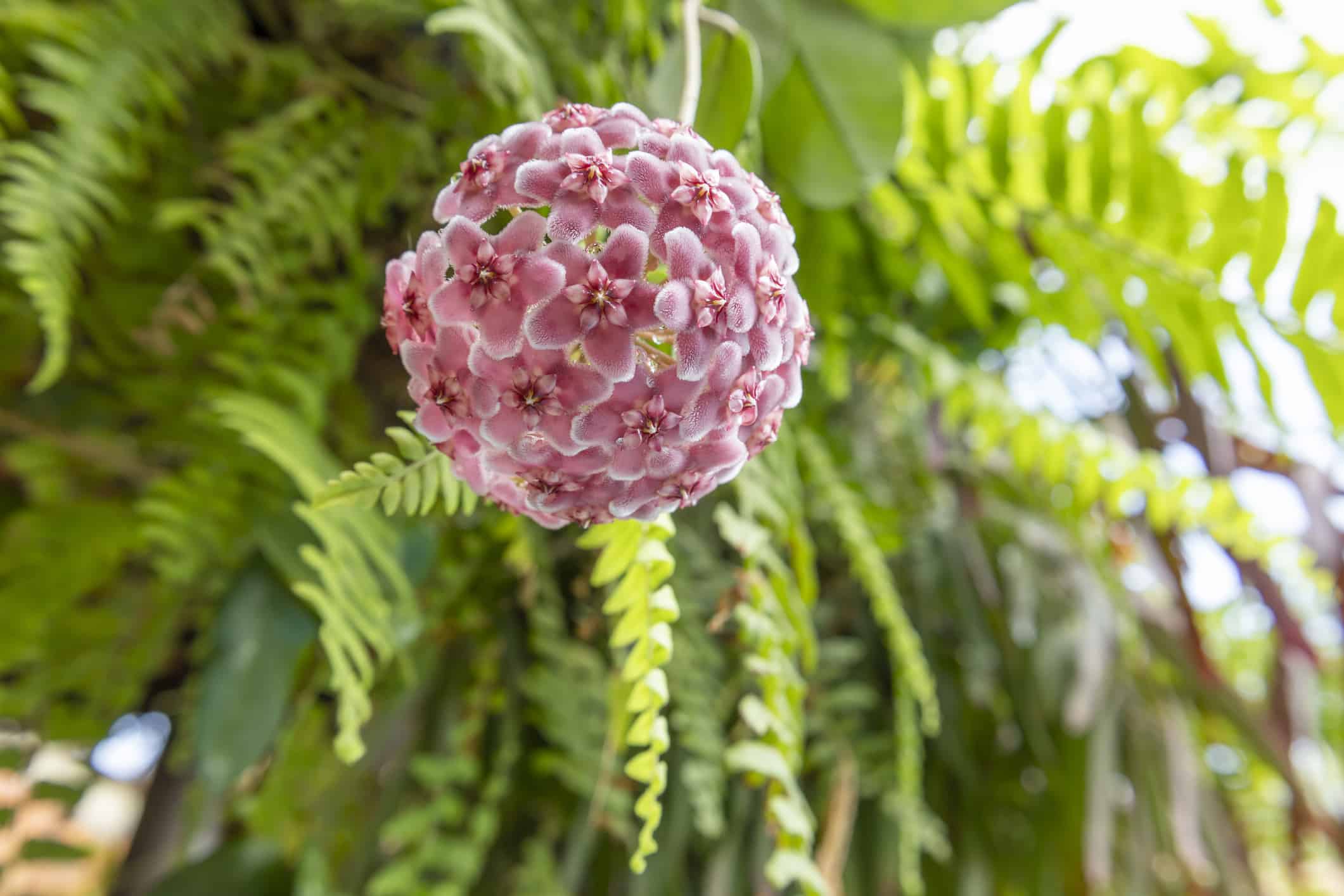
The porcelain flower is a gorgeous indoor plant native to Asia and Australia.
©ibrahim halil yapici/ via Getty Images
Kicking off our list is the delightful porcelain plant. This captivating plant is a member of the dogbane family, Apocynaceae, with roots traced back to Australia and Eastern Asia. What sets this plant apart is its glossy leaves that possess a waxy surface, enhancing its charm.
What’s more, it produces incredibly fragrant flowers that are sure to make your home smell great! The porcelain plant’s succulent stems are smooth and light gray in color, exhibiting tendrils that facilitate its climbing and twining habit. The foliage of this plant, which varies from ovate to elliptical, spans about one to two inches in width and can reach up to five inches in length and height.
2. Betel Leaf Plant (Piper betle)

A luscious green vining plant that grows very well indoors is the betel leaf plant.
©Mohammad Shofi Albarid/ via Getty Images
The betel leaf plant is a charming climber that can serve as an impressive backdrop, enhancing the aesthetics of any area. Its lush, bright green leaves, shaped like hearts, present a rich and full appearance, contributing a dash of nature’s majesty to anywhere that you decide to place it.
This tropical plant originally hails from South and East Asia, presenting not just visual appeal but also notable medicinal benefits. It flourishes both inside and outside, favoring environments that provide steady humidity and a bit of shade.
Fun Fact: The betel leaf is used in Asia as a wrapper for the areca nut, which people have been chewing for hundreds of years due to the euphoric effects. Many people mistakenly refer to the areca nut as the betel leaf, when in fact, the betel leaf is only used to wrap the nut when chewing.
3. Monstera Peru (Monstera karstenianum)
Monstera Peru is an easy-to-maintain indoor vining plant. Known for its rapid and easy growth, monstera Peru’s abundant foliage is truly a visual treat. Its unique leaves, crinkled and radiant, give off a lustrous sheen. The leaf surface, polished and sleek, adds a dash of elegance.
This tropical plant enjoys a brightly lit environment, making any room with a sunny window a suitable spot. Given its affinity for humidity, consider placing your new monstera friend in a well-lit bathroom.
4. Black-Eyed Susan Vine (Thunbergia alata)
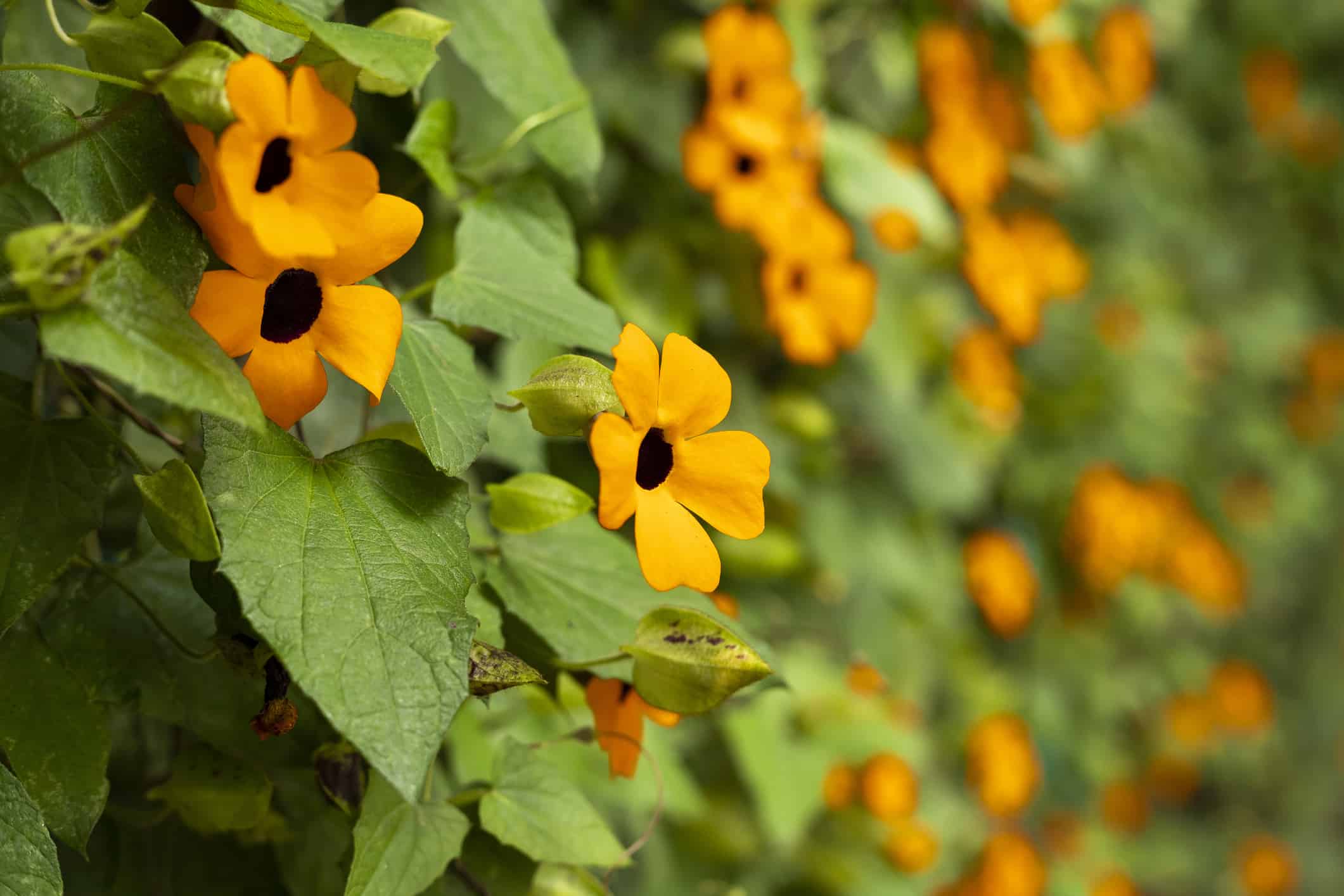
The flowers of a black eyed susan vine are orange with a black circular center.
©Luis Echeverri Urrea/ via Getty Images
Black-eyed susan vine is a striking climbing plant from the Acanthaceae family, native to East Africa. These perennial plants can soar up to 16 feet high in ideal conditions. The leaves of this plant are shaped like an arrow or a heart. You can distinguish them by their undulating edges and fuzzy texture on both sides.
Their orange-yellow flowers, with a set of five petals, blossom all through the growth season, providing a prolonged period of aesthetic delight. These plants flourish in full, unobstructed sunlight, necessitating at least six hours of sunlight daily. However, there’s an exception in hot, arid climates, where it’s advisable to grow these plants in partial shade during the afternoon.
5. Spider Plant (Chlorophytum comosum)
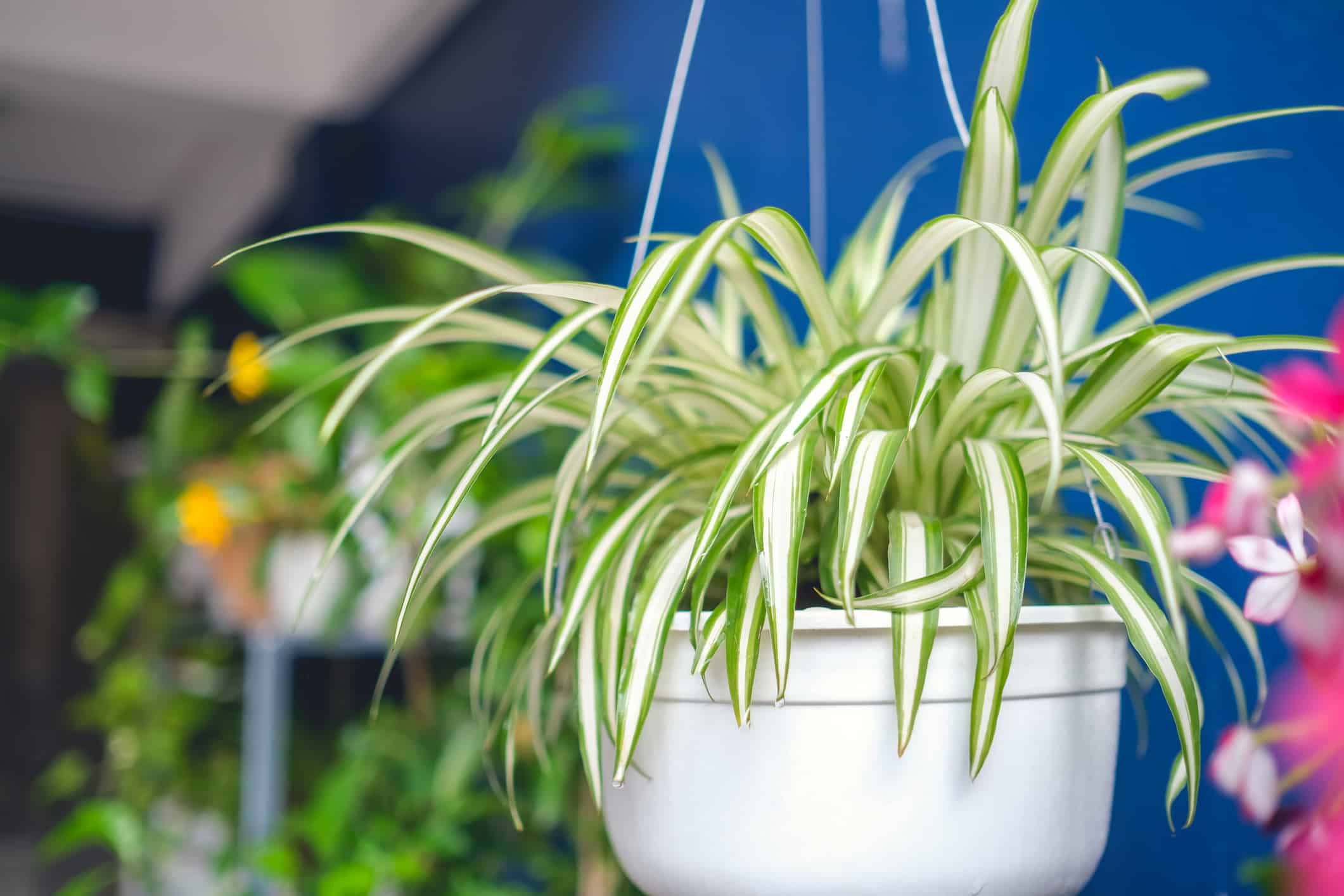
If you are looking for the perfect indoor vining plant, the spider plant may be just the pick!
©yaoinlove/ via Getty Images
Spider plant is a super popular plant and an excellent choice for home decoration owing to its easy cultivation and maintenance. It’s proficient in cleansing the air and prefers to be in compact pots. The plant has elongated green stems graced with white blooms.
It’s best to let the soil slightly dry out between waterings. These plants can withstand periods of dryness, so occasional lapses in watering won’t damage them. Find a spot for the vine that has bright but indirect sunlight. Trimming new growth encourages propagation.
6. Swiss Cheese Plant (Monstera adansonii)

This species of monstera is referred to as the Swiss cheese plant because of the holes in it that resemble Swiss cheese.
©Irfani Kurniawati/ via Getty Images
The Swiss cheese plant is a much-loved choice among vining plants. These tropical plants feature vivid green leaves that are uniquely punctuated with characteristic holes, earning them a resemblance to Swiss cheese.
Their climbing growth pattern allows them to naturally enhance any setting with their delightful presence. While they don’t generally need frequent pruning, trimming them every once in a while will keep Swiss cheese plants at a manageable size.
7. Spiderwort (Tradescantia)
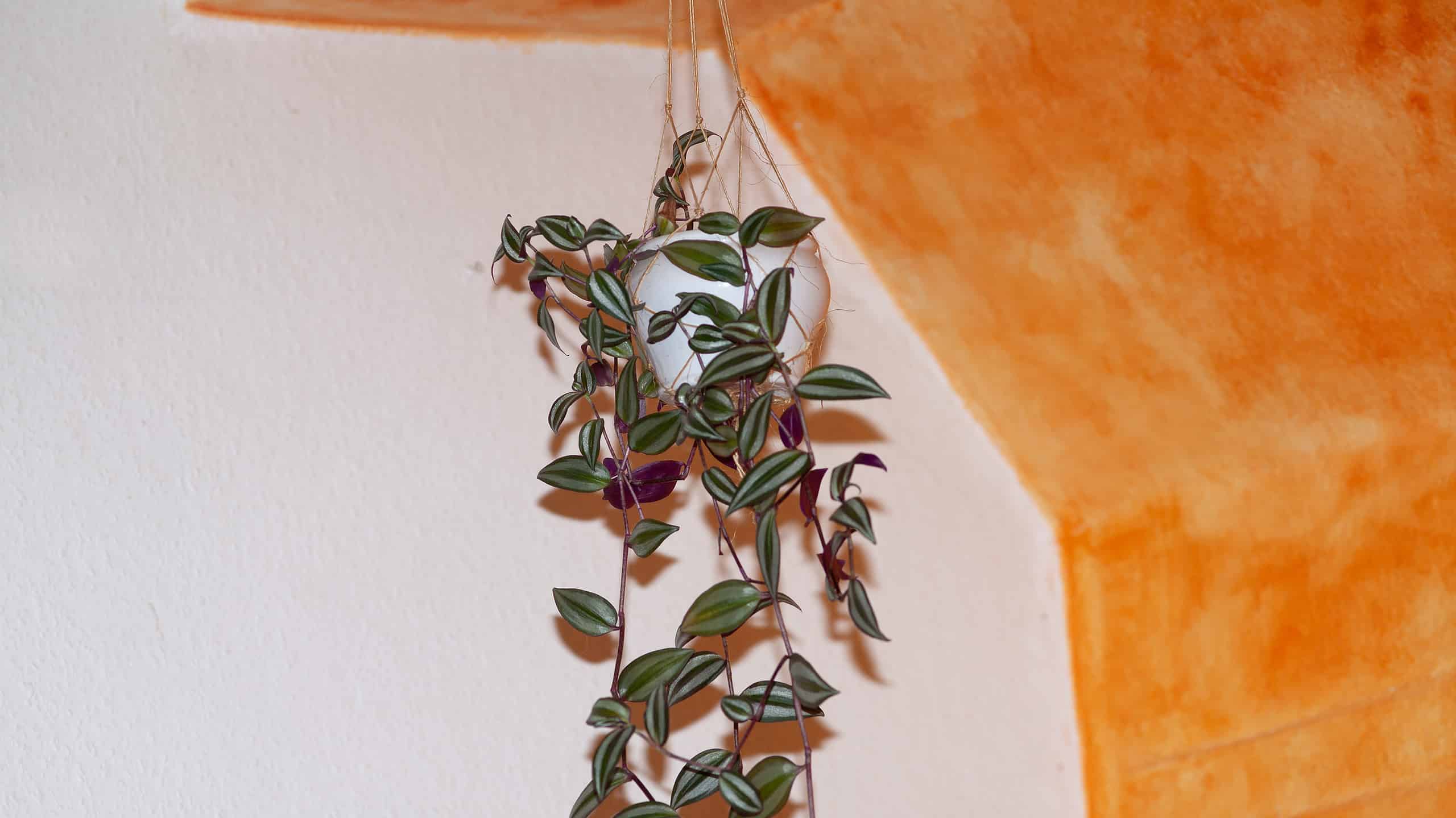
This plant thrives in humid climates and craves a good amount of natural light.
©anjajuli/ via Getty Images
If you’re aiming to boost the homely feel of your bedroom with a dash of greenery, think about adding bedroom vines such as the spiderwort plant. These petite climbing plants not only inject vivid shades of purples and greens, but they also lend a calming ambiance to your personal space.
Favoring warm, humid surroundings and plenty of light, these bedroom vines flourish in well-tended settings. Just be cautious not to place them in excessively dry locations!
8. String of Hearts (Ceropegia woodii)
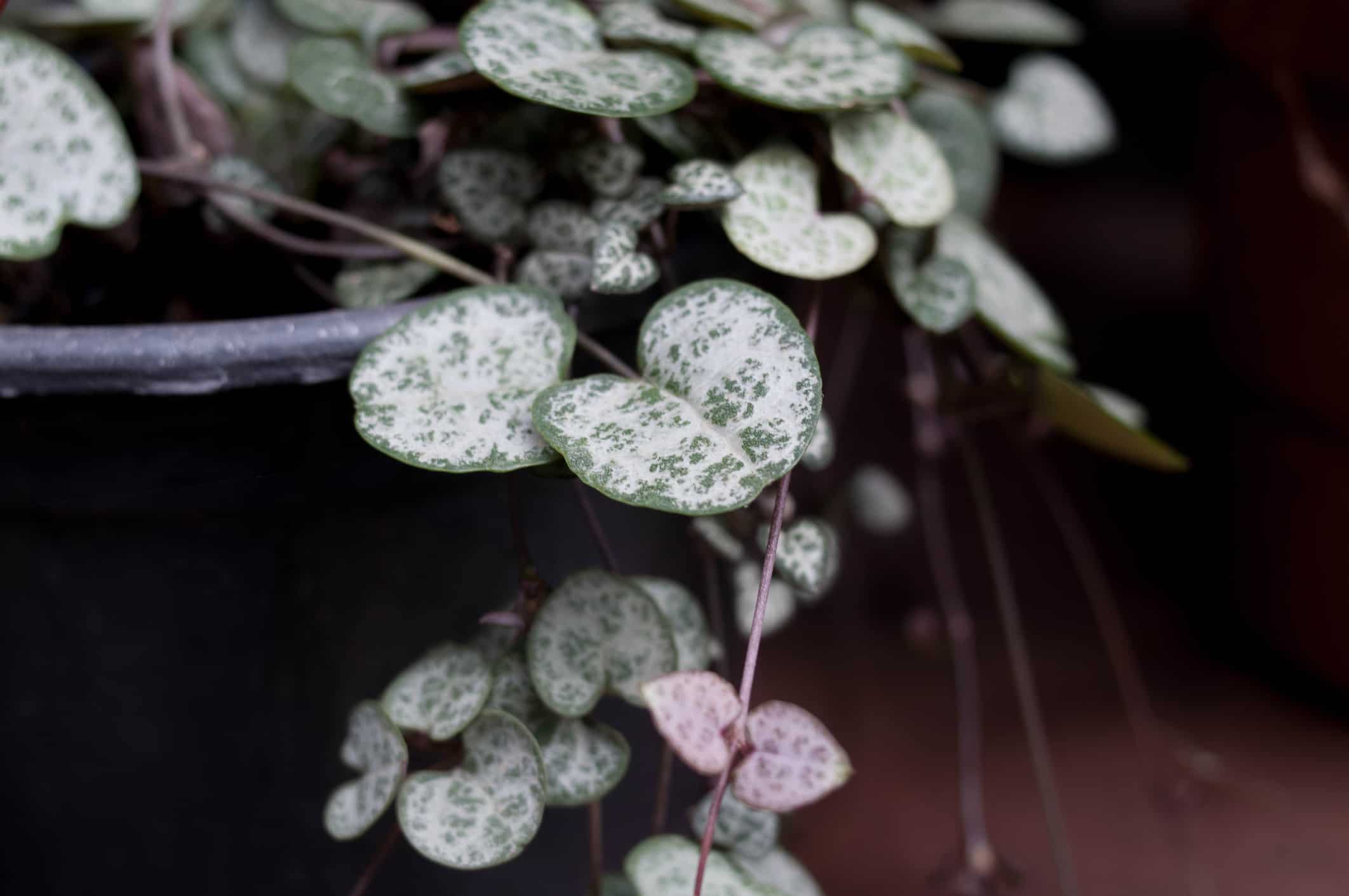
String of hearts is a cute indoor vining plant. The leaves of this plant look like little hearts!
©Vithor Linck/ via Getty Images
Another one of the best indoor climbing plants is string of hearts. String of hearts is a charming climbing plant that looks like a fine necklace adorned with heart-shaped leaves.
Rather than densely clustering on the vine, the leaves spread out along its length, producing an elegant and artistic display. The leaves of the string of hearts plants are also known to occasionally grow tubular flowers, enhancing their attractiveness and visual charm.
It’s even a good fit for a bedroom as it releases oxygen and doesn’t emit carbon dioxide at night.
9. English Ivy (Hedera helix)

One of the most common types of ivy used indoors and outdoors is English ivy. This ivy grows fast and can climb anything!
©Phoenixproduction/ via Getty Images
One of the best indoor vining plants is none other than the famous English ivy. The main reason this makes for a perfect indoor plant is that it thrives in shady areas. This fast-growing, evergreen perennial works both as a climbing plant and as ground cover. English ivy boasts lobed dark green leaves as a juvenile, and as a mature plant, it produces unlobed dark green leaves.
To properly care for your English ivy plant, make sure to prune it regularly, as this plant is an incredibly fast grower in ideal conditions. Place this plant in a bright area of your home with plenty of indirect sunlight. Keep in mind that English ivy is toxic to pets, so keep it out of reach from children, dogs, and cats!
10. Philodendron nanegalense
Philodendron nanegalense is a rare philodendron species with visually striking vines. It flourishes as an indoor plant, lending a unique appeal to any environment. The nanegalense vines are notably graceful and eye-catching, with leaves that are extensive, wide, polished, and deep green in color. The leaves of this plant arrange themselves horizontally along the vine.
Hailing from Ecuador, this particular species is critically endangered, so cultivating it contributes to its conservation.
11. Grape Ivy (Cissus rhombifolia)
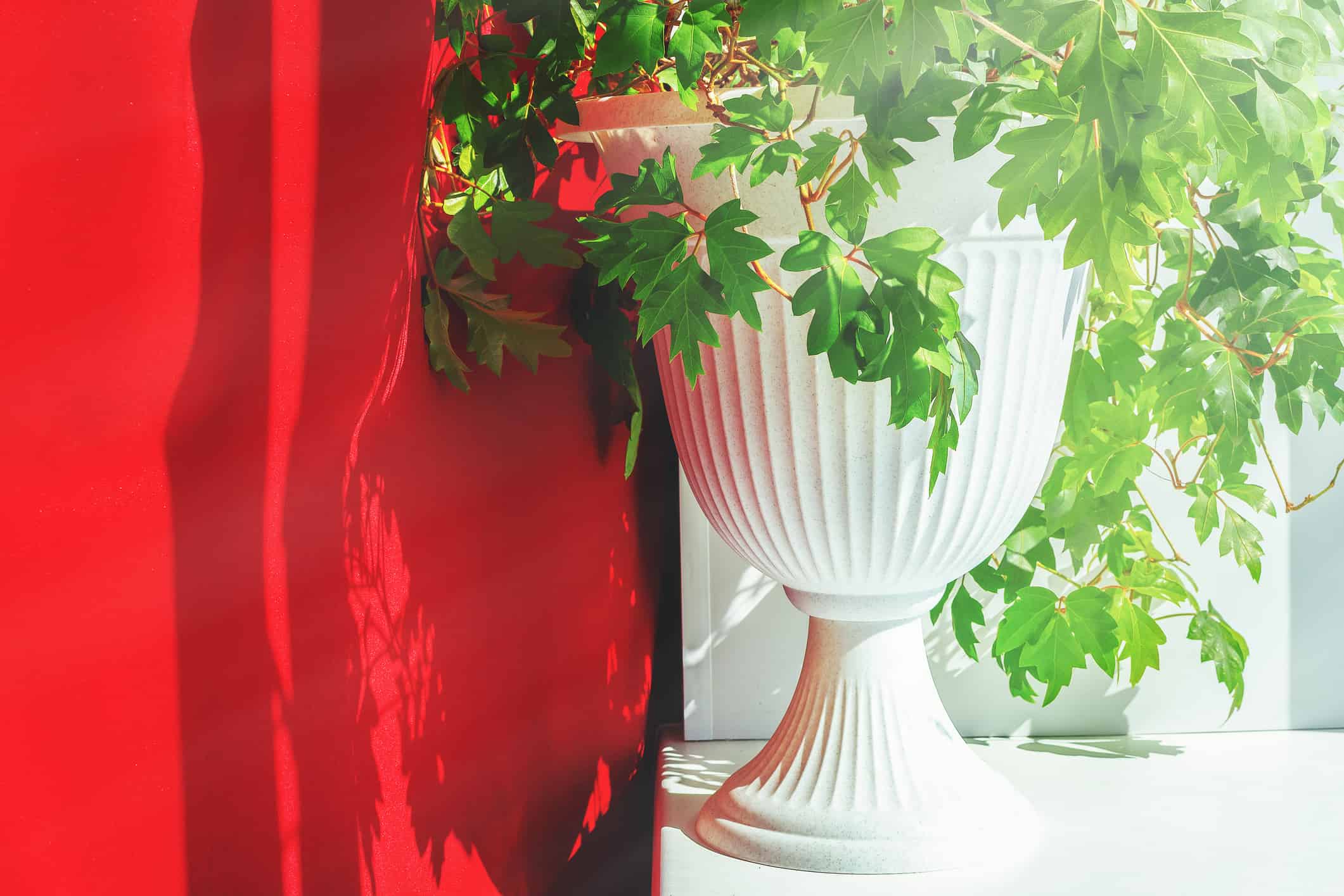
Cissus rhombifolia is easy to care for as an Indoor plant and is a beautiful addition to any home.
©Денис Безобразов/ via Getty Images
Grape ivy is an easy-to-grow climbing plant that brings joy to its caretakers. However, unlike other ivy plants like pothos, these indoor vines don’t flourish in low-light settings. This plant requires a good amount of natural indirect light.
Grape ivy features perennial leaves split into three leaflets (trifoliate), each with roughly serrated edges. The leaves can vary in size from 2 to 9 inches, based on the cultivar and plant’s growth. The leaf color spans a medium to dark green spectrum; to get the leaves to a deeper shade you’ll need to place the plant in substantial shading and sufficient nutrition.
12. Rex Begonia Vine (Cissus javana)

This Southeast Asian vine is one of the best indoor climbing plants to put in your home!
©Dewin ‘ Indew/ via Getty Images
The rex begonia vine is a herbaceous perennial vine that originated in Southeast Asia. Mature rex begonia vines exhibit thin, red stems and can extend up to 10 feet long and 1 foot wide. The slender, ovate leaves have heart-shaped bases and can reach sizes of up to 6 inches long and 4 inches wide. The top layer of the foliage is dark green, speckled with silvery white, while the underside boasts a deep purple-red color.
It thrives in partly sunny conditions with evenly moist, rich, well-draining soil. It also prefers warm and humid environments.
13. Maidenhair Vine (Muehlenbeckia)
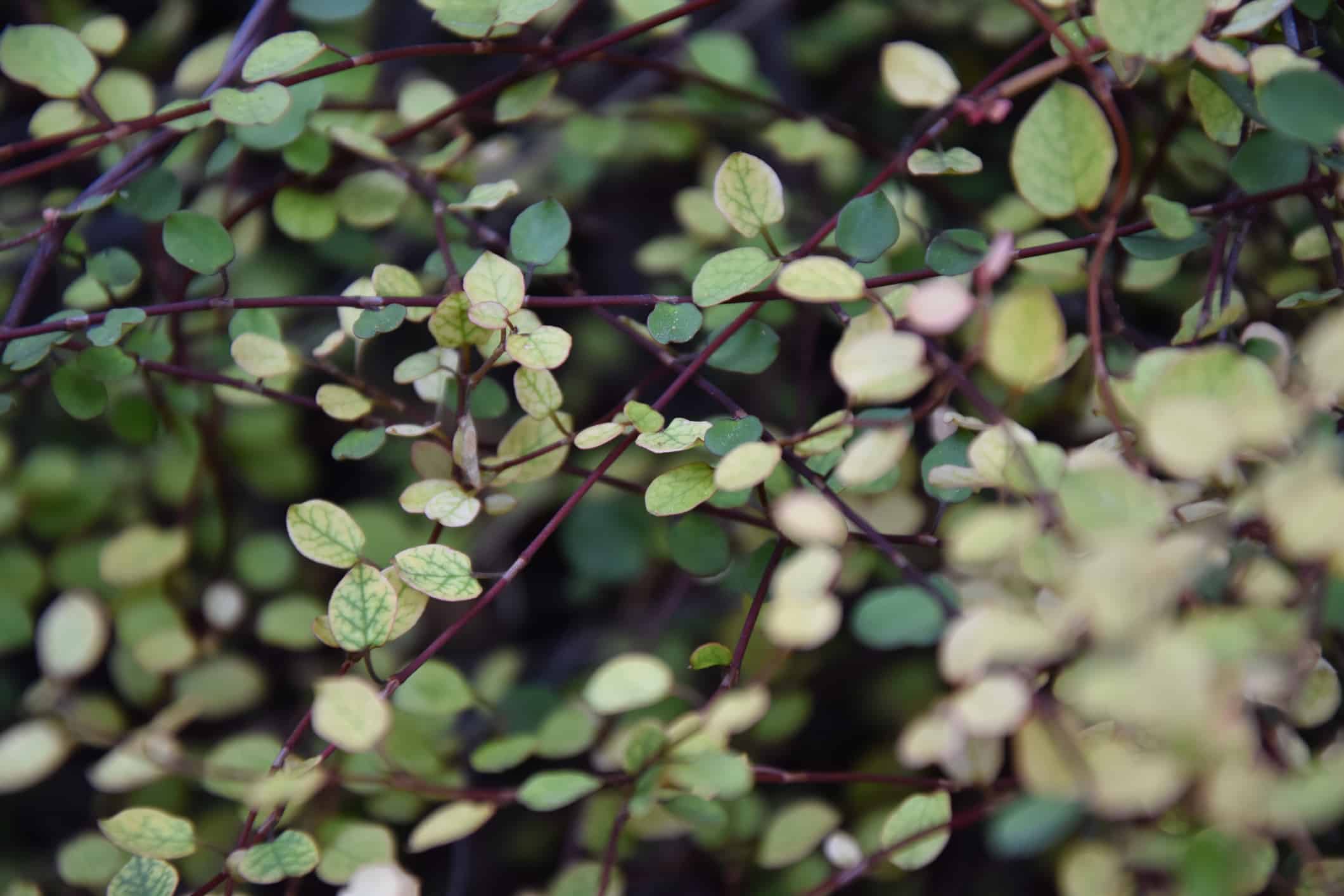
This this vine is originally from New Zealand and is a unique plant to add to your indoor vine collection.
©Robtoz/ via Getty Images
The maidenhair vine is one of the best indoor vining plants. It forms a layer of tiny, glossy, dark green leaves, making it perfect for creating a ground cover effect beneath taller indoor plants. Thanks to its creeping or trailing nature, the maidenhair vine is also ideal for hanging baskets. You can also place it along a mantelpiece, where it will sprawl across the surface.
This evergreen, rapidly growing vine that tends to tangle originates from New Zealand. When fully grown, the plants may yield minuscule, star-like transparent flowers during the summer
14. String of Nickels (Dischidia nummularia)

An interesting vining plant to consider adding to your indoor plant garden is string of nickels.
©ieang/Shutterstock.com
String of nickels earned its name due to the resemblance of its round, coin-shaped leaves to real nickels. This succulent possesses trailing vines that add a touch of gracefulness to any area. Its abundant and plump foliage makes it an excellent choice for hanging baskets, where it can elegantly dangle.
This hanging plant thrives in well-drained soil and prefers bright, indirect sunlight. By providing regular watering and occasional misting, this evergreen creeping plant will thrive and bring a unique charm to both indoor and outdoor gardens.
15. Pink Jasmine (Jasminum polyanthum)

This plant produces amazing pink flowers.
©Udayakumar R/ via Getty Images
Pink jasmine is a highly regarded plant that many gardeners appreciate for its stunning floral showcase. This evergreen vine is vigorous in growth and boasts many intensely fragrant, long-tubed flowers that measure approximately 1 inch across.
The blossoms form dense clusters and showcase white interiors with a delicate rose color on the outside. Pink jasmine is a rapid climber, utilizing twining to ascend. Its long stems have bright to dark green leaves, slightly lighter on the underside, and composed of 5-7 leaflets.
Additionally, this plant is a recipient of the prestigious Award of Garden Merit by the Royal Horticultural Society.
16. String of Pearls (Senecio rowleyanus)
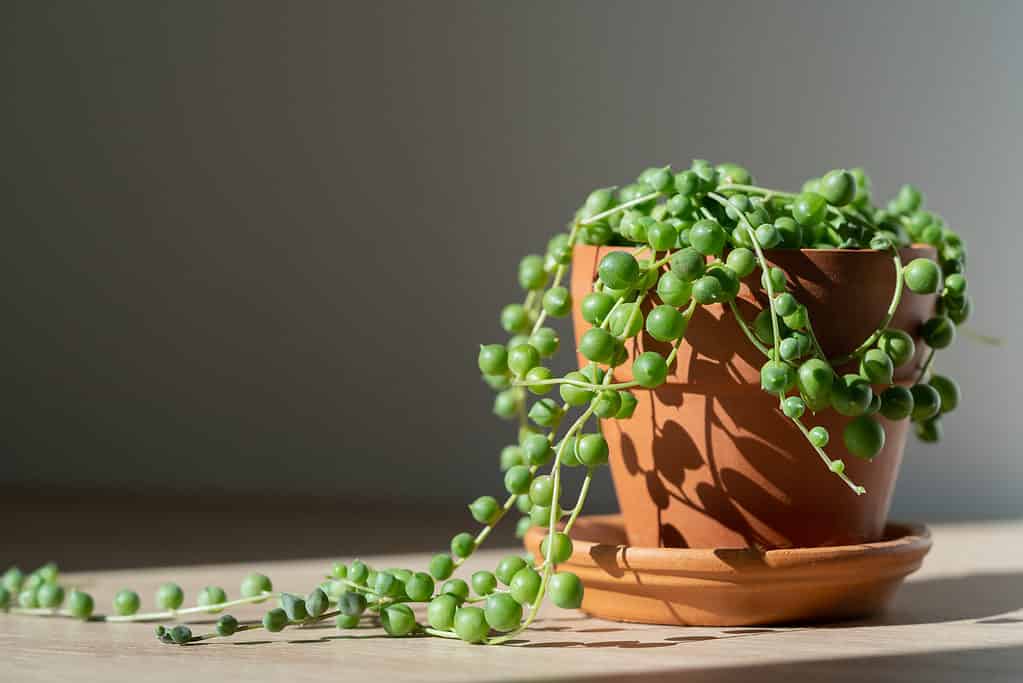
One of the most identifiable vining plants on this list is string of pearls.
©iStock.com/Dima Berlin
String of pearls is an amazing indoor vining plant that can be easily identified by its small, round-shaped leaves resembling peas. These leaves grow on trailing stems, gracefully cascading over the edges of pots and hanging baskets, similar to the string of rubies succulent.
Propagation of this plant can be done by utilizing these stems, as it is a robust and fast-growing variety, adding around five to 15 inches in length each year. However, without propagation, the plant’s lifespan is relatively short.
Although string of pearls plants are commonly cultivated as hanging plants worldwide throughout the year, in their native desert habitat of East Africa, they naturally grow on the ground, forming a low-lying cover.
17. Golden Pothos (Epipremnum aureum)
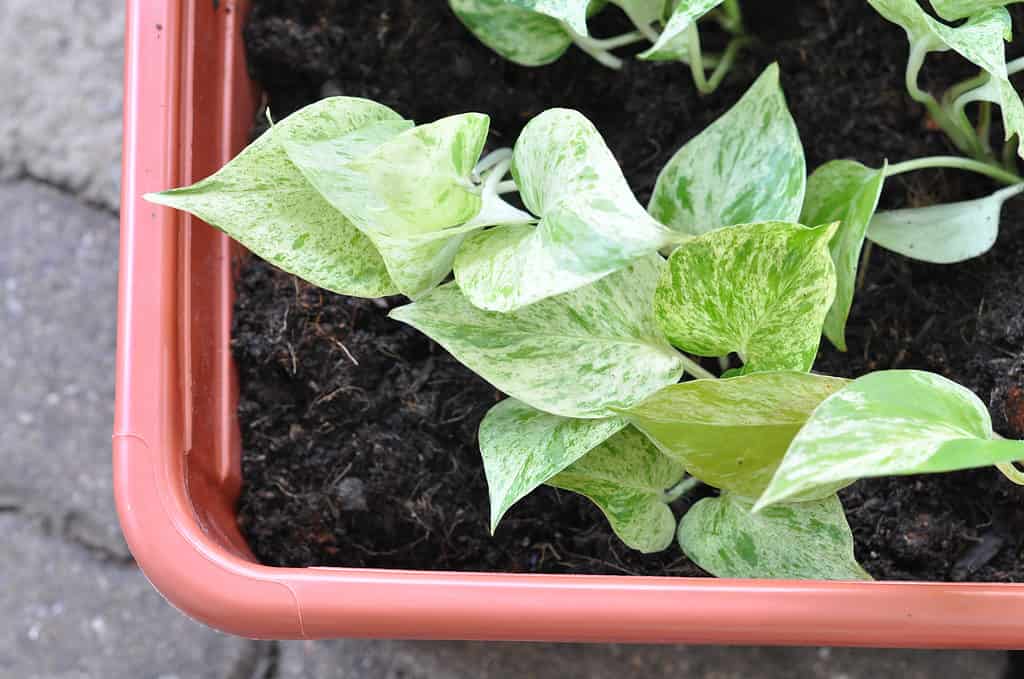
Devil’s ivy or golden pothos is a popular indoor plant that thrives in low to medium light.
©C_banglieng/Shutterstock.com
The golden pothos (also known as devil’s ivy) is one of the most popular indoor vining plants for low light conditions across the globe. Its distinctive heart-shaped leaves, adorned with green and gold hues, have adored shelves and cabinets worldwide for many years.
This plant is incredibly simple to grow and propagate. Just by placing a cutting in a container of water, you can effortlessly grow a new plant. The golden pothos is not only an easy-going plant but also a fantastic air purifier.
18. Creeping Fig (Ficus pumila)

Another beautiful climbing plant is creeping fig. This plant needs good natural lighting to thrive.
©Ekaterina Fedulyeva/ via Getty Images
Creeping fig is one of the best vining plants that you can easily grow both indoors and outdoors. The vines feature regularly shaped, elliptical leaves that are neatly arranged.
Typically, the leaves are green, but there are also variegated varieties available. These varieties showcase a combination of green and cream or green and white foliage, creating a more striking visual impact.
Creeping fig looks splendid when placed in hanging baskets and positioned in well-lit areas. Moreover, it serves as an ideal plant for covering walls on balconies and terraces, in addition to being a suitable choice for a houseplant.
19. Forest Cactus (Lepismium bolivianum)
The forest cactus is a unique evergreen trailing plant that adds a distinctive touch to any indoor space. Its appearance resembles that of a slender, light green cactus, with stems that gracefully cascade from containers and bear long succulent leaves.
This plant exhibits a fascinating blend of cactus-like features and the trailing nature of temperate vines. Hanging baskets or shelves are the perfect places for this plant, resulting in intriguing and lively branches that spice up your indoor decor. In addition to its intriguing appearance, the forest cactus produces beautiful white and pink flowers and is highly tolerant of drought conditions.
20. Arrowhand Plant (Syngonium podophyllum)

This is another perfect plant for the indoors as it does well inside and is drought tolerant.
©Pikusisi-Studio/ via Getty Images
The arrowhead plant is a beautiful indoor vining plant with a distinctive and exotic appearance. True to its name, the leaves of this plant look like arrowheads and can grow quite large, reaching up to 6 inches in length. The leaves also display a rich, deep green color with lighter stripes, adding to their visual appeal. Furthermore, the glossy and shiny texture of the leaves enhances their overall attractiveness.
This plant is an excellent choice if you desire to bring the lush and vibrant ambiance of tropical forests into any corner of your room. You can place this plant on tables, where occasional pruning may be necessary, or on shelves, allowing it to grow a bit more freely.
21. Kangaroo Vine (Cissus antarctica)

If you are looking for a green vining plant to add a natural aesthetic to your home look no further than the kangaroo plant.
©DMVPhotography/ via Getty Images
The kangaroo vine can be described as refreshing, airy, and light. Its leaves have a delicate appearance, resembling cotton or other lightweight materials. The leaves are heart-shaped with beautifully serrated edges, adding an artistic touch. They showcase light and bright green colors, evoking a sense of spring. In terms of appearance, this plant has a herbaceous and bushy nature, reminiscent of temperate forest plants rather than exotic varieties.
It is well-suited for light and casual rooms, where it may not be the focal point but contributes to the vibrancy and freshness of the space.
22. Mistletoe Cactus (Rhipsalis baccifera)
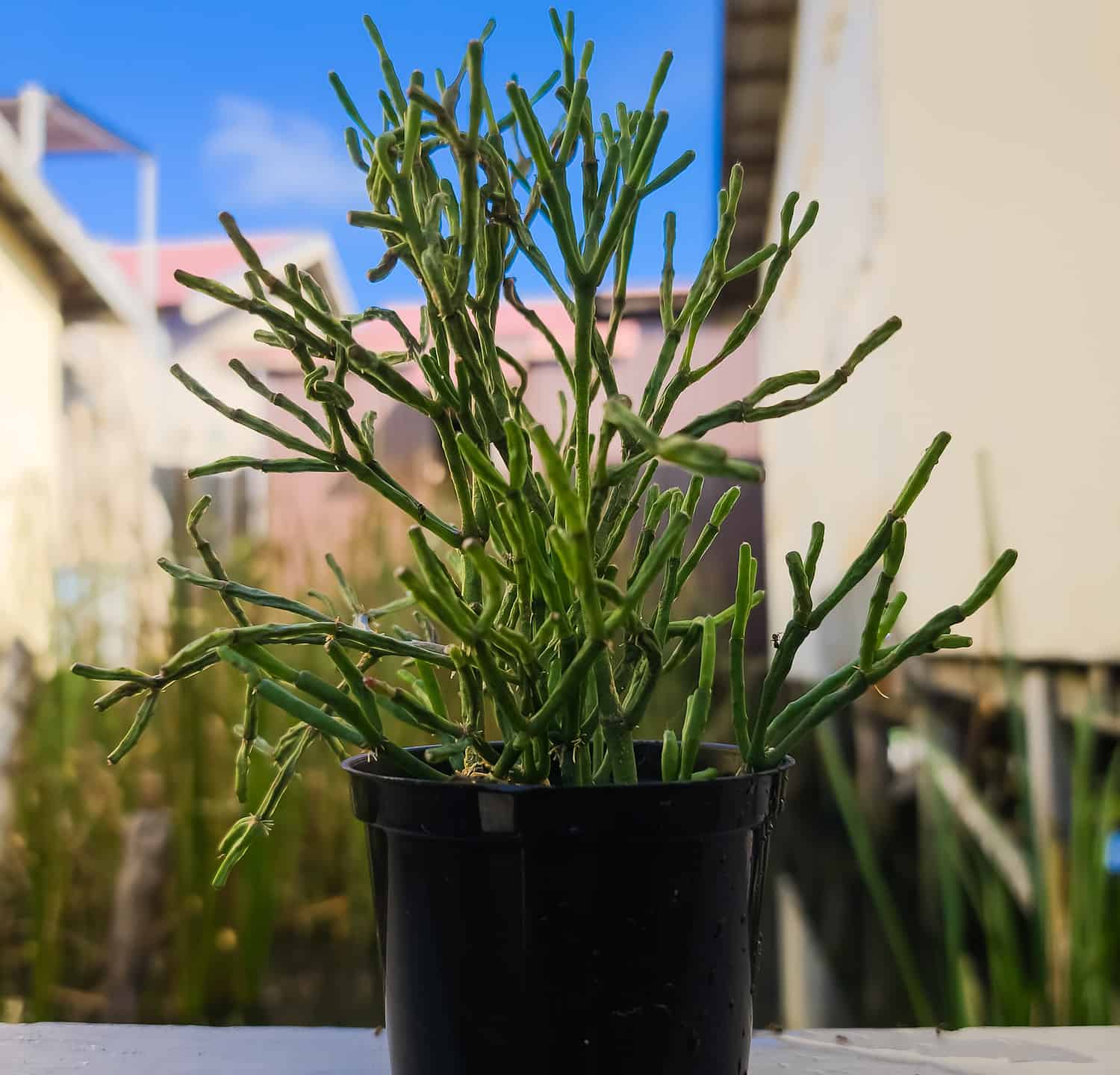
This tropical plant has a unique drooping look when it grows as the vines fall down and hang.
©Dheo Tegar Pratama/ via Getty Images
The mistletoe cactus is a tropical plant that belongs to the cactus family. It is highly appreciated as a houseplant due to its distinctive slender foliage and trailing growth habit.
Its cascading stems create an attractive display when placed in hanging baskets, and its eye-catching foliage adds liveliness to any room.
The mistletoe cactus is generally low-maintenance and thrives indoors with ease. Unlike desert cacti and succulents, this tropical cactus prefers indirect light and requires a humid environment with moist conditions.
Summary of Best and Most Dynamic Indoor Vining and Climbing Plants
| PLant | Botanical Name | Sun Exposure | Where to Place? |
|---|---|---|---|
| Porcelain Flower | Hoya carnosa | Partial sun | Near window with dappled sun |
| Betel Leaf Plant | Piper betle | Filtered sunlight | North- or east-facing corners |
| Monstera Peru | Monstera Karstenianum | Medium indirect sunlight | North-facing window |
| Black-Eyed Susan Vine | Thunbergia alata | Direct sunlight of 6 hours daily | Near support structure |
| Spider Plant | Chlorophytum comosum | Indirect sunlight | Anywhere away from direct sunlight |
| Swiss Cheese Plant | Monstera adansonii | Indirect sunlight | Away from direct sunlight |
| Spiderwort | Tradescantia | Indirect sunlight | Hanging basket |
| String of Hearts | Ceropegia woodii | Partial sun | Shelf or hanging pot |
| English Ivy | Hedera helix | Indirect sunlight | Away from direct sunlight |
| Philodendron Nanegalense | Philodendron nanegalense | Indirect bright light | Away from direct sunlight |
| Grape Ivy | Cissus rhombifolia | Partial sun | East-facing window |
| Rex Begonia Vine | Cissus javana | Partial shade | North- or east-facing windows |
| Maidenhair Vine | Muehlenbeckia | Full sun | Hanging basket |
| String Of Nickels | Dischidia nummularia | Part shade | North- or east-facing windows |
| Pink Jasmine | Jasminum polyanthum | Full sun to part shade | North- or east-facing windows |
| String Of Pearls | Senecio rowleyanus | Indirect sunlight | Hanging basket |
| Golden Pothos | Epipremnum aureum | Indirect sunlight | Away from direct sunlight |
| Creeping Fig | Ficus pumila | Indirect sunlight | Away from direct sunlight |
| Forest Cactus | Lepismium bolivianum | Filtered sunlight | Near a sunny window |
| Arrowhead Plant | Syngonium podophyllum | Filtered sunlight | Away from direct sunlight |
| Kangaroo Vine | Cissus antarctica | Partial shade | Hanging basket |
| Mistletoe Cactus | Rhipsalis baccifera | Indirect sunlight | Away from direct sunlight |
Thank you for reading! Have some feedback for us? Contact the AZ Animals editorial team.







